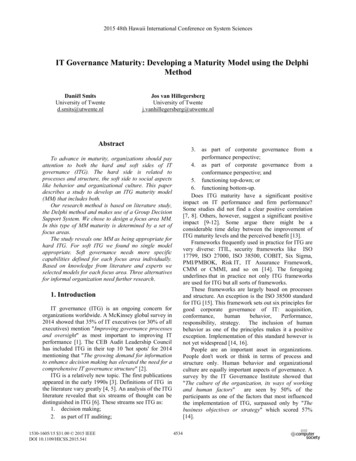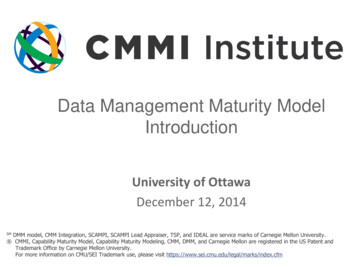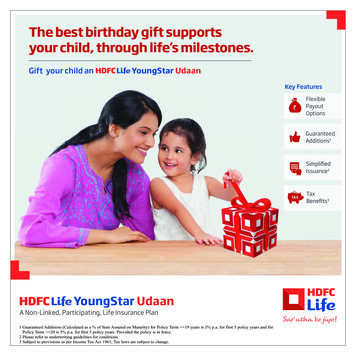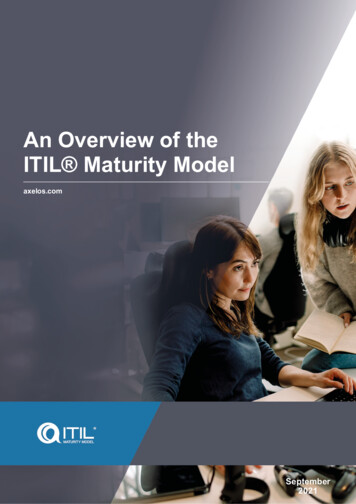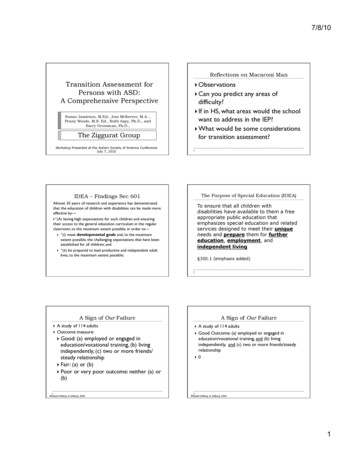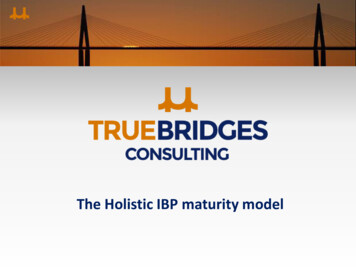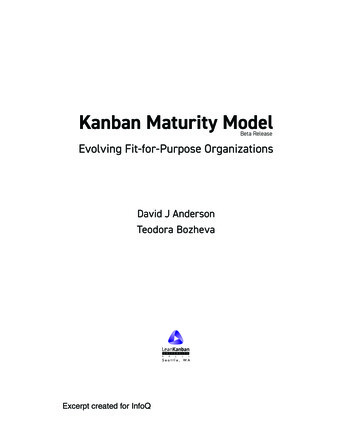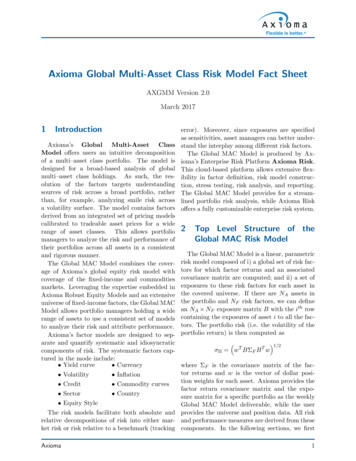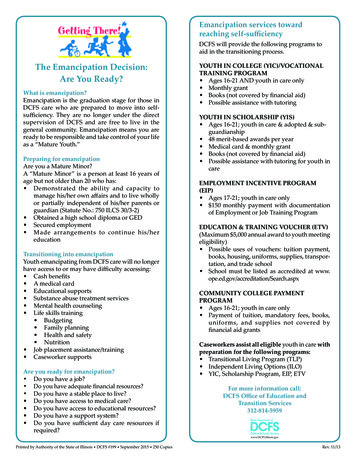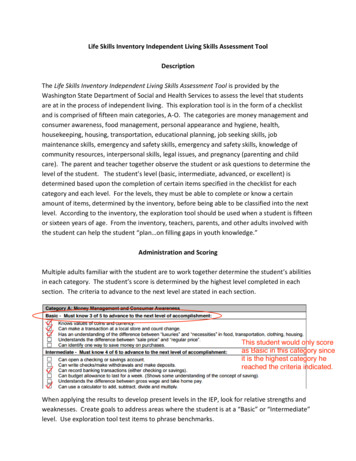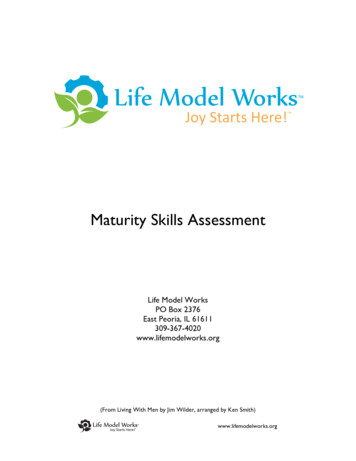
Transcription
Maturity Skills AssessmentLife Model WorksPO Box 2376East Peoria, IL 61611309-367-4020www.lifemodelworks.org(From Living With Men by Jim Wilder, arranged by Ken Smith)www.lifemodelworks.org
AlwaysSometimesUsuallyNoInfant stageMotivations and RegulationsChild stageCompetencyAlwaysUsuallySometimesNoI have experienced strong, loving, caring bonds with mother/a women.I have experienced strong, loving, caring bonds with father/a man.Important needs were met until I learned to ask.Others took the lead and synchronized with me and my feelings first.Quiet together times helped me calm myself with people around.Important people have seen me through the "eyes of heaven."I can both receive and give life.I receive with joy and without guilt or shame.I can now synchronize with others and their feelings.I found people to imitate so that I now have a personality I like.I learned to regulate and quiet the "big six" airI can return to joy from every emotion and restore broken relationships.I stay the same person over time.I know how to rest.I can do things I don't feel like doing.I can do hard things (even if they cause me some pain.)I can separate my feelings, my imagination and reality in myrelationships.I am comfortable with reasonable risks, attempts and failures.I have received love I did not have to earn.I know how my family came to be the way it is--family history.I know how God's family came to be the way it is.I know the "big picture" of life with the stages of maturity.I can take care of myself.I ask for what I need.I enjoy self-expression.I am growing in the things I am good at doing (personal resources andtalents.)I help other people to understand me better if they don't respond well to meI have learned to control my cravings.I know what satisfies me.I see myself through the "eyes of heaven."www.lifemodelworks.org
AlwaysUsuallySometimesNoAdult stageAlwaysUsuallySometimesNoI have had a rite of passage into adulthood by the communityI am comfortable relating to the same sex communityI have a peer group where I belongI can partner with othersMy relationships are marked by fairness and mutual satisfactionI protect others from my power when necessaryI protect my personal and group identity when boundaries are violatedI live in a way that expresses my heartI have a diverse set of roles and responsibilitiesI make important contributions to my family and communityI can bring two or more people back to joy at the same timeI use my sexual power wiselyI can proclaim my spiritual identityI can see others through the “eyes of Heaven.”Pre-marriage Check List for MenI have a well developed adult maturityMy labors are productiveI give life to others with styleI have experienced life as:BrotherFriendPriestLoverWarriorKingServantAll of these togetherwww.lifemodelworks.org
sUsuallySometimesNoI have brought others to lifeI have an encouraging partnerI receive guidance from eldersI have peers that hold me accountableI have a secure and orderly home and communityI can give without needing to receive in returnI see my family through the eyes of heavenI include others in family activitiesI am present with my familyI am protective of my familyI am attentive to my familyI am calming to my familyI enjoy my familyI comfort my familyI help my children matureI can synchronize the needs of wife, children, family, work & churchI have a community of people to call my ownI am recognized by my communityI have a proper place in the community structureI am valued and defended by the communityI demonstrate hospitalityI give life to the “familyless”I help my community matureI build and maintain the community identityI don’t abandon when I disengageI share others’ feelings but still know who I am and who they areI continue to be the same person when provoked or temptedI bear up well nsI see some of what God sees in every situationI enjoy what God put in each and everyoneI live transparently and spontaneouslyI build and rebuild trustwww.lifemodelworks.org
The LIFE Model of Redemption and MaturitySo hurt people wouldn’t spend their lives simply recovering and “getting by,” a small butdedicated group of pastors, counselors, prayer ministers, deliverance workers, abuse survivors,support people and parents looked, studied and prayed their way to a model that would guideus from birth to death—a LIFE model.A growing number of books, tapes, videos, conferences and training seminars use aspects of thelife model but its essentials are found in a small book called The Life Model: Living From TheHeart Jesus Gave You.This book has been translated in several languages. The LIFE Model is used around the worldfor trauma treatment, addiction recovery, community development, church design, child rearingand Christian missions.The LIFE Model is, as its name implies, a model for life from conception to death. It is anidealized model, that is to say, it proposes what life should be like rather than describing whatlife on earth generally produces.The LIFE model suggests that people need five things in order to thrive:1. A place to belong2. To receive and give life3. The capacity to recover from things that go wrong (desynchronizations)4. To mature as they get older5. To live from their identities (hearts)These elements develop when we share joy and sorrows together as natural and spiritualfamilies in peaceful homes. The LIFE Model covers both our growth and recovery. These fiveelements apply whether we consider physical growth, emotional growth, family growth,community growth or spiritual growth. Taken in order from one to five, these elements areneeded for strong and healthy human growth. Taken in reverse order, starting with living fromour true identities, these same elements form an excellent diagnostic grid for a failure to thrive.By understanding the causes for failures to thrive we can design a restoration process. The LIFEModel explains how to restore our identities as individuals, families and communities so that welive from a completely synchronized and authentic identity we call “the heart that Jesus givesus.” This authentic identity is as much communal as it is individual.Deep in the right hemisphere of every human brain is a control center that develops during thefirst two years after conception. This center will run our lives and bodies and, provided wedevelop a strong one, will see us through the tempests of life. We seek to train and restore thiscontrol center. With it we can regulate our emotions, act like ourselves and stay synchronizedinside and out.www.lifemodelworks.org
We become traumatized when the emotional intensity of life exceeds our capacity to maintainsynchronization between the four levels of our control center. Thriving means building a strongcontrol center through joyful attachment bonds that bring peace and return us to joy when webecome upset.We develop our identities by responding and resonating when we see the characteristics wepossess expressed by an older and more experienced person. Identity is propagated likecuttings from live plants and not grown from seeds. This way of growing an identity by receivingthe life passed on from one who went before is true for us at a physical level just as it is at anemotional and spiritual level.What makes the LIFE Model a Christian model is a division between redemption and maturity.While most people will agree that not everyone matures correctly, some would say that allhuman beings could reach their full maturity by purely human means. Christians would say, “notwithout help.” Some believe that everything needed for full human maturity is already containedwithin each person. Christians would say, “Something is still missing.”It takes a mutual effort between people and their God to fully live and experience life as it wasmeant to be lived. God clearly separates divine areas of responsibility from human areas ofresponsibility. Humans are responsible for maturity. God is responsible for redemption.The LIFE Model is a profoundly Christian blueprint for wholeness for individuals, families,churches and communities across the lifespan.The LIFE Model is a unifying approach to ministries of counseling, recovery, pastoral care,prayer ministry, deliverance, inner healing, child rearing, body life and health.The LIFE Model is used internationally for substance abuse recovery programs. It has beenwidely used as a church model. Missions have adopted the model for the restoration ofmissionary children. Almost every major ministry that deals with trauma and abuse victims inthe USA uses and distributes the LIFE Model as part of their teaching.The theory behind this book was developed at Shepherd’s House Inc. in California. Pastors,counselors prayer team members, lay leaders, people in recovery and an international advisorypanel from many traditions and theoretical perspectives worked together to formulate thisprofoundly Christian view of life.www.lifemodelworks.org
Where can I learn more about the Life Model?www.lifemodelworks.orgOverview of the Life Model, downloads, handouts, resources in various languages, materials forsale, training, staff, events, contact information, newsletters, projects, donations, Shepherd’sHouse Inc., current board membership and not-for-profit corporate information, maps of LifeModel activities and a central search function can be located at this web site.Joy Starts HereJoy Starts Here: The Transformation Zone is arguably the most important book written on thetopic on joy and could be the beginning of a joyful revolution, a new way of life for us all. Thebook includes 9 weekly Bible studies, assessments, joy building activities and group exercises.We recommend this book as a group study, or better yet for your entire church to use in theirsmall groups.www.lifemodelworks.org
THRIVE: Relational Brain Skills TrainingTHRIVE is intensive skill training for your nervous system and spirit. THRIVE is a brilliant andcomplete training program using brain science and the presence of Jesus to free you from fearsand struggles that waste so much life. Down inside, you have always known there wassomething more to friendship, parenting, marriage, church or even counseling, than what youhave seen. You have worked hard, tried the usual spiritual and counseling solutions but didn’tthrive. THRIVE is the strategic solution for the training you missed growing up! With THRIVEyou increase your capacity to handle distressing emotions and stay productive. The joy peopleat Life Model Works designed THRIVE for you, using the Life Model.THRIVE applies the Life Model’s 19 brain and character skills. THRIVE makes joy yourfoundation - spiritually, mentally and relationally. THRIVE lets you feel loved while you masterdifficult emotions. THRIVE helps you live in God’s presence so you are transformed. THRIVEhelps you stay connected with the people you love - even in painful emotions! THRIVE trainingincludes international conferences, maturity retreats and Joy Rekindled Marriage Retreatswhere you live or training materials you can use at home.CONNEXUSFormerly Thriving: Recover Your Life, Connexus is an innovative and comprehensive lifetraining program comprised of 3 different modules that will help you: Learn skills to engage God in order to grow spirituallyRecover from painful addictions, trauma and attachment painLearn to create community and healthy relationships around youDiscover how to experience the presence of God in a way that healsExperience how God can heal the barriers that we put up in our relationshipsOne of the most unique and exciting elements of Connexus is that it brings people of all levelsof maturity together to build a joyful healing community. This is one aspect of our program thatyou won’t find anywhere else. Participants heal and grow by building joy in the context ofsecure, healthy relationships with God and others. As joy builds, they are better able to handledistress and increasingly able to live from their heart.Connexus incorporates the latest advances in neuroscience with the Life Model conceptsand the 19 relationship skills needed to thrive. This program is revolutionizing churches,recovery programs and other ministries all over the world.www.lifemodelworks.org
A growing number of books, tapes, videos, conferences and training seminars use aspects of the . emotional growth, family growth, community growth or spiritual growth. Taken in order from one to five, these elements are needed for strong and healthy human growth. Taken in reverse order, st

